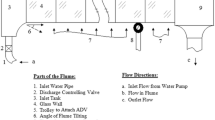Abstract
In this paper, a numerical study of flow in the turbulence boundary layer with adverse and pressure gradients (APGs) is conducted by using Reynolds-averaged Navier-Stokes (RANS) equations. This research chooses six typical turbulence models, which are critical to the computing precision, and to evaluating the issue of APGs. Local frictional resistance coefficient is compared between numerical and experimental results. The same comparisons of dimensionless averaged velocity profiles are also performed. It is found that results generated by Wilcox (2006) k-w are most close to the experimental data. Meanwhile, turbulent quantities such as turbulent kinetic energy and Reynolds-stress are also studied.
Similar content being viewed by others
References
Coleman GN, Kim J (2003). Direct numerical simulation of a decelerated wall-bounded turbulent shear flow. Journal of Fluid Mechanics, 495, 1–18.
Granville SP (1987). Baldwin Lomax factors for turbulent boundary layers in pressure gradients. AIAA Journal, 25(12), 1624–1627.
Inoue M, Pullin DI, Harun Z (2013). LES of the adverse-pressure gradient turbulent boundary layer. International Journal of Heat and Fluid Flow, 44, 296–300.
Johnson DA, King LS (1984). A new turbulence closure model for boundary layer flows with strong adverse pressure gradients and separation. AIAA Journal, 1984–0175.
Knopp T, Schanz D, Schroeder A (2014). Experimental investigation of the log-law for an adverse pressure gradient turbulent boundary layer flow at Re (theta)=10000. Flow, Turbulence and Combustion, 92(1), 451–471.
Launder BE, Sharma BI (1974). Application of the energy dissipation model of turbulence to the calculation of flow near a spinning disc. Lett. Heat Mass Transfer, 1, 131–138.
Lee J, Sung HJ (2008). Effects of an adverse pressure gradient on a turbulent boundary layer. International Journal of Heat and Fluid Flow, 29(3), 568–578.
Liu XF, Thomas FO, Nelson RC (2002). An experimental investigation of the planar turbulent wake in constant pressure gradient. Physics of Fluids, 14(8), 2817–2838.
Lu LP, Li ZR (2002). Coherent structures in turbulent boundary layer with adverse pressure gradients. Journal of Beijing University of Aeronautics and Astronautics, 28(4), 417–419.
Menter FR (1994). Two-equation eddy-viscosity turbulence models for engineering applications. AIAA Journal, 32(8), 1598–1605.
Pailhas G, Touvet Y, Aupoix B (2008). Effects of Reynolds number and adverse pressure gradient on a turbulent boundary layer developing on a rough surface. Journal of Turbulence, 9(43), 1–34.
Rahgozar S, Maciel Y (2012). Statistical analysis of low- and high-speed large-scale structures in the outer region of an adverse pressure gradient turbulent boundary layer. Journal of Turbulence, 13(46), 1–24.
Saffman PG (1970). A model for inhomogeneous turbulent flow. Proceedings of the Royal Society of London, Series A: Mathematical and Physical Sciences, 317, 417–433.
Samuel AE, Joubert PN (1974). Boundary layer developing in an increasingly adverse pressure gradient. Journal of Fluid Mechanics, 66(3), 481–505.
Schlichting H (2003). Boundary-layer theory. 8th edition, Springer, New York, USA.
Spalart PR, Allmaras SR (1994). A one-equation turbulence model for aerodynamic flows. Recherche Aerospatiale, 1, 5–21.
Spalart PR, Watmuff J (1993). Experimental and numerical study of a turbulent boundary layer with pressure gradients. Journal of Fluid Mechanics, 249, 337–371.
Tulapurkara EG, Khoshnevis AB, Narasimhan JL (2001). Wake-boundary layer interaction subject to convex and concave curvatures and adverse pressure gradient. Experiments in Fluids, 31(6), 697–707.
Wilcox DC (2006). Turbulence modeling for CFD. 3rd edition, DCW Industries, La Canada, CA, USA, 124–126.
Yorke CP, Coleman GN (2004). Assessment of common turbulence models for an idealized adverse pressure gradient flow. European Journal of Mechanics B/Fluids, 23, 319–337.
Author information
Authors and Affiliations
Additional information
Foundation item: Supported by the National Natural Science Foundation of China (Nos.51309040, 51379033, 51209027, 51309025), Open Research Fund of State Key Laboratory of Ocean Engineering (Shanghai Jiao Tong University) (Grant No.1402), and Fundamental Research Fund for the Central Universities (DMU3132015089).
Rights and permissions
About this article
Cite this article
Yong, Z., Zhi, Z., Li, Z. et al. Turbulence model investigations on the boundary layer flow with adverse pressure gradients. J. Marine. Sci. Appl. 14, 170–174 (2015). https://doi.org/10.1007/s11804-015-1303-0
Received:
Accepted:
Published:
Issue Date:
DOI: https://doi.org/10.1007/s11804-015-1303-0




